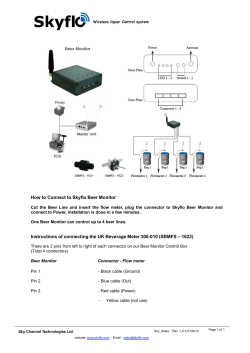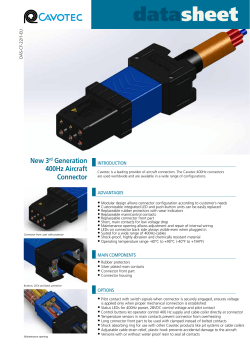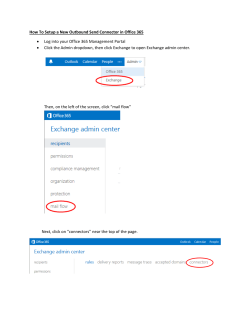
UBA Ultrasonic Fork Sensors - WayCon Positionsmesstechnik
ULTRASONIC Fork Sensors Series UBA fork sensor Key-Features: Content: Technical Data Technical Drawing Description Teach-In & Fork Widths Electrical Connection Order Code & Accessories 18.12.14 ....2 ....2 ….3 ....4 ….5 ....5 - Ultrasonic fork sensor with analogue output 0...10 V, where the analogue signal is a function of the lateral covering - For edge control and web guidance systems - For transparent foils - Works in contaminated air - High accuracy and temperature stability - High detection width - Very small plane change influence - High sampling rate - Measurement range teachable -2- TECHNISCHE TECHNICAL DATA DATEN UBA-AT-30/60-24-CU UBA-AT-40/70-24-CU Fork width [mm] 30/60 40/70 Detection width [mm] approx. 8 (±4) approx. 13 (±6.5) Resolution (noise): - when 20...80 % covered - when 0...100 % covered [mm] [mm] Plane change (influence of position between transmitter S and receiver E): <7 mm off E or S >7 mm off E or S <5 mm off E or S >5 mm off E or S approx. 0.1 approx. 0.15 Linearity at 10...90% covered (typical) [mm] [mm] [mm] [mm] [%FS] ≤ ±0.3 ≤ ±0.1 ≤2 Ultrasonic frequency [kHz] approx. 180 Sampling frequency (in non synchronized mode) [Hz] 500 Output signal [V] Temperature stability 0...60°C (typical) Power supply voltage Ripple of supply voltage Current consumption at 24 VDC Power consumption ≤ ±0.5 ≤ ±0.1 ≤4 approx. 130 285 0...10 [%] ±5 [VDC] 8...30 [%] 10 [mA] 35 [W] 0.9 Power indicator 3 LED yellow/green/yellow in keyboard Working temperature [°C] 0...+60 Storage temperature [°C] -10...+70 Synchronization input (connector pin 2) - square wave signal (on rising edge) - min. signal duration - max. sampling frequency (for proper signal) [V] [ms] [Hz] Max. cable length [m] 3.5 ... 30 0.02 500 3.5 ... 30 0.02 285 20 Protection class IP67 Housing material black anodized aluminium Electrical connection M12-connector, 4-pole Weight [g] 200/220 TECHNICAL DRAWING UBA-AT-40/70-24-CU UBA-AT-30/60-24-CU 360/400 -3- DESCRIPTION Advantages of ultrasonic fork sensors 1) The UBA ultrasonic transducers have a large diameter. Result: large measurement range combined with high linearity and resolution. 2) The signals are compensated with computed data as well as with a temperature sensor. Result: precise operation up to 60°C. 3) The sensors have the teach-in function. Result: They can be adapted to the actual air condition and the material. 4) Software and transducers are designed to eliminate the influence of multiple echoes. The UBA are ultrasonic through beam sensors with separated transmitter and receiver. They are suited for edge detection on web guiding systems. In contrast to conventional barriers they do not offer a simple on/off output signal, but they measure the degree of covering of the ultrasonic receiver as an analogue output signal. If the receiver is fully covered, the output is 0 V and if not covered at all 10 V. But the ultrasonic fork barrier is much less sensitive to dirt and dust compared to optical sensors. Furthermore transparent materials such as foils can be perfectly handled. The relative humidity of air and the air pressure as well (sea level) have an influence on the output signal due to physical laws (attenuation of sound). Higher air humidity or decreasing air pressure do reduce the output signal at a given edge position. - 4 -- TEACH-IN Teach-In With the teach-in the signal output can be defined at fully closed fork (status A) as well as at fully open fork (status B). Status A: If there is an acoustically non transparent material in the fork, no signal is recorded by the receiver and thus the sensor shows 0 V. However if the material is partly acoustically transparent (e.g. textiles), the sensor would show an offset. By teaching this status the offset can be eliminated and the full 10V span is available. For teaching the status A the material must be fully introduced into the fork. Status B: If there is nothing between transmitter and receiver, the sensor should show the full signal of 10 V. As explained above, the signal can slightly vary depending on air conditions. By teaching this status the full range signal can be adjusted to exactly 10 V. For teaching the status B the fork must be fully free of material. In addition, the output signal can also be inverted via teach-in, i.e. either rising or falling signal with increasing coverage of the sensor. • Status A (material is fully introduced): push key A for min. 2 s until yellow LED near A blinks 3x (acknowledgment by lighting of all 3 LEDs) • Status B (no material in fork): push key B for min. 2 s until yellow LED near B blinks 3x (acknowledgment by lighting of all 3 LEDs) • Inverting the signal: push both keys A and B simultaneously for min. 5 s until yellow LED near A lights up. Then release keys. Acknowledgement by lighting of all 3 LEDs. Reverse the inverting by the same procedure. • Factory reset: push both keys A and B simultaneously for 10 s until green LED lights up. Then release keys. Acknowledgment by lighting of all 3 LEDs. • Key lock: push both keys A and B simultaneously for 15 s until yellow LED near B lights up. Then release keys. Acknowledgement by lighting of all 3 LEDs. Unlock the keys in the same way. Teach-In by the connector Pin 2 of the connector has besides the function synchronization also the same teach function as Key B. The adjustment of the max. signal output at fully open fork can therefore also be done by connecting pin 2 with power supply voltage (nom. 24 VDC) during min. 2 s. Subsequently, the pin 2 must be removed from the supply. The sensor can e.g. be operated after the teaching process with a 3 wire cable as well. Teach via connector is possible also if the key lock is enabled. Status A: 0 V or 10 V inverted Status B: 10 V or 0 V inverted FORK WIDHT Larger fork widths are of importance if the material web is vertically heavily flattering or if it does not always pass at the same position during unroll or roll up (see picture below). -5- SYNCHRONIZATION The internal sampling clock of the sensor can be overcome with an external repeating signal. This can be helpful if several sensors are measuring along a fast moving web. ELECTRICAL CONNECTION Sensor: M12 connector, 4 pole(View on the sensor) Connection cable Cable with connector M12, 4 poles, shielded PIN Function Pin 1 +24 V Pin 2 Synchronisation-/Teach-In Input Pin 3 0V Pin 4 Analog output 0...10 V K4P2M-S-M12 2 m, connector straight K4P5M-S-M12 5 m, connector straight K4P10M-S-M12 10 m, connector straight K4P2M-SW-M12 2 m, connector angular K4P5M-SW-M12 5 m, connector angular K4P10M-SW-M12 10 m, connector angular PIN No. cable colour PIN No. cable colour Pin 1 brown Pin 3 blue Pin 2 white Pin 4 black ORDER CODE UBA AT 24 CU Measurement range [mm] e. g. 40 30 / 40 / 60 / 70 OVERVIEW UBA-AT-30-24-CU 30 mm, 0...10 V UBA-AT-60-24-CU 60 mm, 0...10 V UBA-AT-40-24-CU 40 mm, 0...10 V UBA-AT-70-24-CU 70 mm, 0...10 V ACCESSORIES Connection cable with M12 connector, 4 pole, shielded K4P2M-S-M12 2 m, straight connector K4P2M-SW-M12 2 m, angular connector K4P5M-S-M12 5 m, straight connector K4P5M-SW-M12 5 m, angular connector K4P10M-S-M12 10 m, straight connector K4P10M-SW-M12 10 m, angular connector Subject to change without prior notice. WayCon Positionsmesstechnik GmbH E-Mail: info@waycon.de Internet: www.waycon.de Head Office Mehlbeerenstr. 4 82024 Taufkirchen Tel. +49 (0)89 67 97 13-0 Fax +49 (0)89 67 97 13-250 Office Köln Auf der Pehle 1 50321 Brühl Tel. +49 (0)2232 56 79 44 Fax +49 (0)2232 56 79 45
© Copyright 2025









